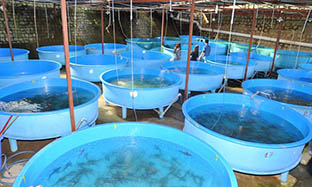.jpg)
How to reduce Ammonia in Pond?
Ammonia is toxic to fish if allowed to accumulate in fish production systems. When ammonia accumulates to toxic levels, fish can not extract energy from feed efficiently. If the ammonia concentration gets high enough, the fish will become lethargic and eventually fall into a coma and die.
In properly managed fish ponds, ammonia seldom accumulates to lethal concentrations. However, ammonia can have so-called “sublethal” effects—such as reduced growth, poor feed conversion, and reduced disease resistance—at concentrations that are lower than lethal concentrations.
Ammonia in water is either unionized ammonia (NH3) or the ammonium ion (NH4 +). The techniques used to measure ammonia provide a value that is the sum of both forms. The value is reported as “total ammonia” or simply “ammonia.” (In this publication, “ammonia” refers to the sum of both forms; the specific forms will be referred to as appropriate.) The relative proportion of the two forms present in water is mainly affected by pH. Un-ionized ammonia is the toxic form and predominates when pH is high. Ammonium ion is relatively nontoxic and predominates when pH is low. In general, less than 10% of ammonia is in the toxic form when pH is less than 8.0. However, this proportion increases dramatically as pH increases (Fig. 1).
The proportion of toxic, un-ionized ammonia increases as a function of pH and temperature. To determine the proportion of un-ionized ammonia in a water sample, draw a line from the pH of the water straight up to the line that is closest to the water temperature. From that point, draw a line to the right until it intersects the graph’s vertical axis. That point is an estimate of the percentage of un-ionized ammonia in the water sample. Now, simply multiply that number (divided by 100) by the total ammonia concentration to estimate the un-ionized ammonia concentration.
The measurement of ammonia concentration (and that of many other water quality variables) provides only a snapshot of conditions at the time a water sample is collected. A single measurement provides no insight into the processes that affect ammonia concentrations; it is simply the net result of processes that produce ammonia and processes that remove or transform ammonia. The relationships among these processes are complex, but the important point is that the rates change differentially throughout the year and result in the measured patterns.
Ammonia Sources
The main source of ammonia in fish ponds is fish excretion. The rate at which fish excrete ammonia is directly related to the feeding rate and the protein level in feed. As dietary protein is broken down in the body, some of the nitrogen is used to form protein (including muscle), some is used for energy, and some is excreted through the gills as ammonia. Thus, protein in feed is the ultimate source of most ammonia in ponds where fish are fed.
Another main source of ammonia in fish ponds is diffusion from the sediment. Large quantities of organic matter are produced by algae or added to ponds as feed. Fecal solids excreted by fish and dead algae settle to the pond bottom, where they decompose. The decomposition of this organic matter produces ammonia, which diffuses from the sediment into the water column.
The effect of daily fluctuation in pH on un-ionized ammonia concentration in fish ponds. The top horizontal line indicates a total ammonia concentration of 2.5 mg N/L, which is assumed not to change during the day.
The two curved lines indicate daily changes in un-ionized ammonia concentration where the maximum afternoon pH is 9.0 or 9.5. These conditions indicate that fish may be exposed to toxic, un-ionized ammonia concentrations for brief periods during the late afternoon.

